KelaCream EDTA Heavy Metal Detox Cream – 8oz
$89.90
Kelacream is a topical cream which delivers Calcium Disodium EDTA into the body transdermally.
Kelacream is a topical cream which delivers Calcium Disodium EDTA into the body transdermally. CaNa2EDTA is a synthetic amino acid clinically proven to pull toxic heavy metals out of the body. Best results using EDTA come from getting the EDTA into the body without going through the stomach, intestines and liver. Generally, this has been done using the intravenous method, but now with a transdermal application, it can be done in the privacy of your own home and with a lower dosage so medical supervision is not required. Other than the temporary mild side effects of any chelation/detox program, EDTA has been used safely since the early part of the 20th century and has been used in medicine since the 1950s to treat both mercury and lead poisoning.
Transdermal Delivery
The application of medications to the skin to ease ailments is a practice that has been utilized by humankind over the millennia and has included the use of poultices, gels, ointments, creams, and pastes.
Transdermal Delivery Systems (TDDS) offer advantages over the oral route and improved patient acceptability and compliance.
Apply to Thin Skinned Areas
What you put ON your body is just as significant as what you put IN your body. Your skin is the largest organ of your body and since it is porous, it absorbs whatever you put on it.
There are several layers of skin that serve as protection. However, one layer, the stratum lucidum isn’t even present in thin skin. And the thickest part of the epidermis, the stratum corneum, consisting of keratin-packed dead cells, is substantially thinner in areas of the body such as the inner thigh, under the arm near the axilla, the inside of the wrist, etc. Reducing the stratum thickness can speed up the diffusion of small water-soluble molecules into the body by up to 1000 times!
A study published in the American Journal of Public Health looked into the skin’s absorption rates of chemicals found in drinking water. It showed that the skin absorbed an average of 64% of total contaminant dosage. Other studies found an absorption rate of 100% for underarms and genitalia. There is nearly an 80-fold difference in skin thickness between the thinnest and thickest skin in different parts of the body.
Therefore, to achieve the best absorption, EDTA cream should be applied to areas on the body (not face) where the skin is thinner as mentioned above.
Additional Information:
Apply Kelacream to completely dry & clean skin (no perfumes/other creams should be present). It may take several minutes for the EDTA to be completely absorbed while some of the carrier cream remains on the skin. It can be rubbed in or used on other parts of the body. I personally take the 1 dose amt. and do half of it 2x/day (about 1/2 level teaspoon 2x/day).
You may also experience a normal slight tingling or itchy sensation for a few minutes when first applying the Kelacream depending on skin type, thickness and sensitivity. It is also common to experience a temporary slight rash on the body while detoxing.
Please remember, Kelacream is for topical use only.
The Importance of Mineral Replenishment:
Here’s something very important to remember when doing heavy metal chelation: because of EDTA does not discriminate, beneficial minerals as well as heavy metals will be removed from the body as well. Therefore, to restore homeostasis, the patient must receive a mineral supplement with trace minerals formulated in proper balance. They actually work in concert with EDTA to attach to unwanted elements and compounds in the body and further detoxify the system.
We Are ALL Toxic!
On a daily basis our bodies come in contact with harmful compounds that can cause numerous health challenges, disease, and a decreased quality of life. Harmful toxins are found in the air we breathe, the food we eat and the water we drink. If you’re alive, you absolutely HAVE harmful toxins circulating throughout your body. It’s impossible to avoid.
In today’s environment, these toxins come in many types. However, one type often overlooked by the traditional health care system is toxic heavy metals. Common metals such as lead, mercury, aluminum, cadmium and arsenic are widespread toxic elements that are exceptionally harmful. Awareness of the dangers of these toxic heavy metals has increased over the last decade, but real understanding of their systemic cytotoxic danger is still emerging.
A “heavy metal” is a metal with high atomic weight and specific gravity. With both slow and prolonged (chronic) exposure, as well as acute gross exposure, inorganic heavy metal contact generates systemic intra-cellular and extra-cellular cytotoxins to the brain, nervous system and body.
Constant exposure at work and/or home to heavy metals is of concern. The metals most dangerous are the heavy metals, such as: antimony, arsenic, bismuth, cadmium, cerium, chromium, cobalt, copper, gallium, gold, iron, lead, manganese, mercury, nickel, platinum, silver, tellurium, thallium, tin, uranium, vanadium, and zinc. What people fail to realize completely is that in an inorganic, large, heavy metal form, these metals are harmful to one’s health. However, if they are in a carbon-bonded, trace mineral form, these organically complexed elements are actually beneficial for the body and are necessary to maintain a proper level of energy, health and wellness.
Heavy metal toxicity could lead to a number of health problems, including, but not limited to: damaged or reduced mental and central nervous function, lower energy levels, and damage to the brain, blood composition, lungs, kidneys, liver, and other vital organs. Long-term exposure may result in slowly progressing physical, muscular, and neurological degenerative processes that mimic Alzheimer’s disease, Parkinson’s disease, muscular dystrophy, and multiple sclerosis.
Acute toxicity is relatively easy to diagnose due to immediate and severe symptom onset, usually with known exposure or ingestion. Symptoms of acute heavy metal toxicity may include:
Nausea, vomiting, headaches, sweating, difficulty breathing, neuro-cognitive difficulties (speech, reasoning), and convulsions.
Symptoms of chronic exposure are similar to those of acute exposure, but are much harder to associate to a specific cause because the symptoms generally develop slowly over years of sustained exposure. Patients may fail to seek treatment or diagnosis due to the chronic nature of symptoms. Diagnosing a person with chronic heavy metal exposure can be difficult because chronic exposure symptoms may present themselves as various other ailments and can include:
- nausea
- impaired cognitive, motor, and language
- nervousness and emotional instability
- insomnia
- muscle and joint pain
- allergies
- general and chronic malaise
- weakened immunity
- auto-immunity
- intestinal dysbiosis, IBS, etc.
- allergies
- pain and inflammation
The human body has no ability to remove toxic heavy metals from extra-cellular spaces, interstitial fluids or fatty tissue. Because of this, chelation therapy has become the treatment of choice for this process. Chelation therapy helps reduce the levels of heavy metals in the body, thereby reducing the production of free radicals and preventing peroxidation or breakdown of cell membranes, DNA, enzymes, lipoproteins and many other key metabolic and neurological functions. Additionally, reducing “free-radical” threats and damage may free up the body’s natural healing mechanisms so it can focus on halting and possibly even reversing the progression of disease.
EDTA (Ethylene Diamine Tetraacetic Acid), has been known as a broad-based chelator of heavy metals since the 1920’s when it was used industrially, and now is one of the most widely used chelating agents in medicine with the capacity to attach and remove (chelate) almost every heavy metal.
Due to its rapidly expanding acceptance, ground-breaking doctors like Norman Clark, M.D. observed peripheral benefits such as improvement in cardiovascular health (i.e., cholesterol and arterial plaque removal), and thus discovered EDTA’s ability to chelate more than just inorganic lead.
Benefits of EDTA Chelation Therapy
FDA approved for removal of lead and other toxic metals
It can optimize Nitric Oxide production
Has the potential to reduce blood pressure
It can eliminate intermittent claudication
It has been associated with removal of calcium from arteriosclerotic plaque
Proponents of Chelation Therapy claim that EDTA can reduce the production of free radicals by up to a million-fold! Research over the past 30 years has confirmed the benefits of EDTA.
There are various methods of introducing EDTA into the body: I.V. administration, orally, suppositories and transdermal application.
Although the I.V. administration is well known and has been used for many years, there are disadvantages such as: excessive stress on the liver and kidneys, time and cost (this method is very expensive. One infusion can cost over $100 and some clinicians recommend up to 30 infusions over 12 to 16 weeks for a total cost of several thousands of dollars that insurance may not cover).
EDTA can also be taken orally. However, there are several disadvantages with this method. The biggest disadvantage is that the EDTA has to pass through the gastro-intestinal (G.I.) tract, where digestive enzymes and acids break down the EDTA and diminish its effectiveness. Because of the low absorption, a patient would have to take approximately 7 to 20 times as much oral EDTA to get the same amount of EDTA in the blood as they would with the I.V. or rectal route of administration. Two main problems with taking such large quantities of oral EDTA to achieve similar results is that it exponentially increases the cost and could irritate the stomach and/or intestines.
Therefore, many clinicians believe the two best methods for EDTA delivery are: rectal suppositories and topical skin application via a cream & trans-dermal carrier agent, which seems to be the most appealing.
With EDTA cream, the disadvantages of I.V. are avoided, while an effective treatment is maintained. The use of a transdermal cream is non-invasive and can be done from the comfort of a patient’s own home without the direct supervision of a doctor.
As with most detoxification programs, mild side effects may occur such as: aches, fatigue or rashes. These are all temporary and will likely cease once the system is cleansed.
1 review for KelaCream EDTA Heavy Metal Detox Cream – 8oz
Only logged in customers who have purchased this product may leave a review.

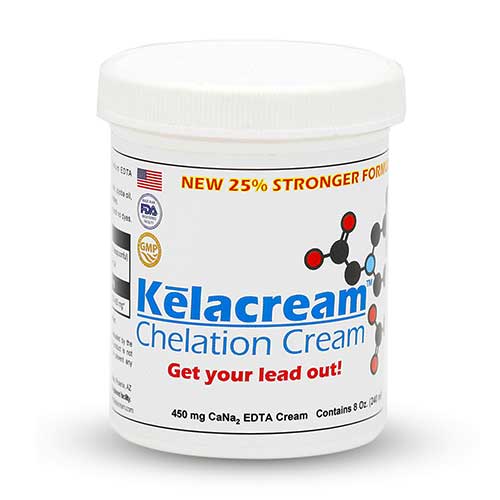
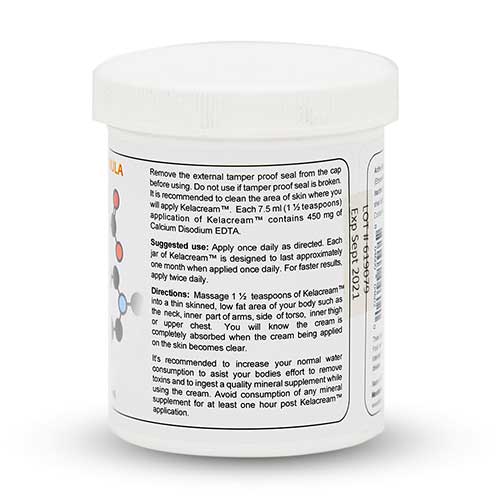
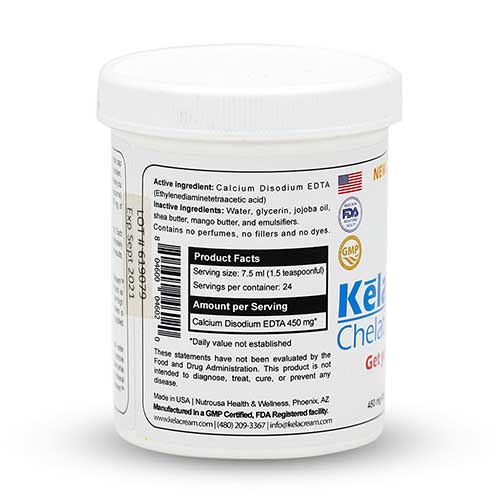

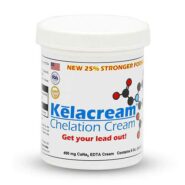
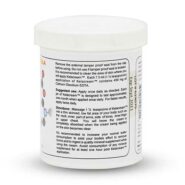



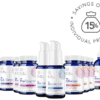
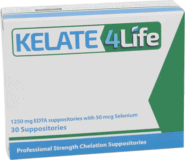

Ronald Bashista (verified owner) –
Easiest to apply where you need it.
Seems to work very well.